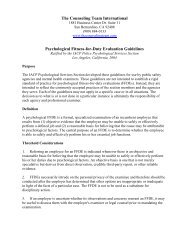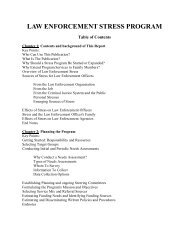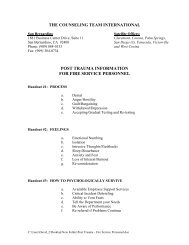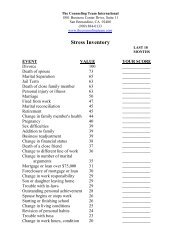ISSUES AND PRACTICES.pdf - The Counseling Team International
ISSUES AND PRACTICES.pdf - The Counseling Team International
ISSUES AND PRACTICES.pdf - The Counseling Team International
Create successful ePaper yourself
Turn your PDF publications into a flip-book with our unique Google optimized e-Paper software.
(4) Improve relations with the union by working together on a program that can mutuallybenefit both parties.We hope to see better labor-management relations as a result of the FOCUS program [theConnecticut Department of Correction stress program]. <strong>The</strong>re should be spinoffs from FOCUSthat will improve relations [with the union] in other areas.--Maria Houser, deputy commissioner for administration, Connecticut Department ofCorrection(5) Show concern for employees by demonstrating that the department cares about its staff ashuman beings, not just as employees.With the stress program, things that were never addressed before get attended to: If there is anaccident or an assault and an officer is hospitalized, Dick [Gould, a staff member] is there. Hemakes sure they are cared for and talks to the officer's wife. A paramilitary organization can getimpersonal, so the program gives credence to the fact that the DOC cares about its employees.--Dennis Cullen, deputy director for labor relations, Massachusetts Department of CorrectionHow Severe Is Correctional Officer Stress?A review of the literature and interviews with more than 50 knowledgeable individuals makeclear that job-related stress is widespread--and possibly increasing--among correctional officers.Many supervisors (lieutenants and captains) also experience considerable job-related stress.<strong>The</strong>re are many sources of stress for correctional officers, including--Organization-related conditions, such as understaffing, overtime, shift work, andunreasonable supervisor demands.Work-related sources of stress, including the threat of inmate violence, actual inmateviolence, inmate demands and manipulation, and problems with coworkers.A poor public image and low pay.A few facts illustrate the stressful nature of correctional work:Many officers do not answer their home telephones because it might be the institutioncalling for overtime. Some officers get a second, unlisted telephone number that theykeep secret from the department.Between 1990 and 1995, the number of attacks on correctional officers in State andFederal prisons jumped by nearly one-third, from 10,731 to 14,165, at a time when thenumber of correctional officers increased by only 14 percent.Except for police officers, the number of workplace nonfatal violent incidents is higherper 1,000 employees for correctional officers than for any other profession, including taxidrivers, convenience store staff, mental health workers, and teachers. From 1992 to 1996,there were nearly 218 incidents for every 1,000 correctional officers, for a total of 58,300incidents.
















